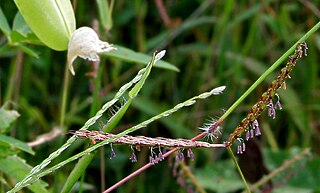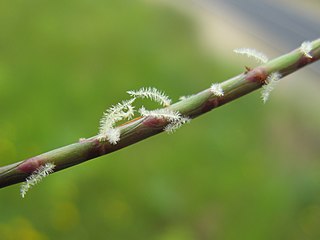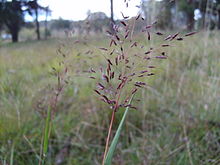
Saccharum is a genus of tall perennial plants of the broomsedge tribe within the grass family.

Cymbopogon, also known as lemongrass, barbed wire grass, silky heads, oily heads, Cochin grass, Malabar grass, citronella grass or fever grass, is a genus of Asian, African, Australian, and tropical island plants in the grass family. Some species are commonly cultivated as culinary and medicinal herbs because of their scent, resembling that of lemons . The name cymbopogon derives from the Greek words kymbe and pogon "which mean [that] in most species, the hairy spikelets project from boat-shaped spathes." Lemongrass and its oil are believed to possess therapeutic properties.

Antidesma is a genus of tropical plant in the family Phyllanthaceae formally described by Linnaeus in 1753. It is native to tropical Africa, S + E + SE Asia, Australia, and various oceanic islands. The greatest diversity occurs in Southeast Asia.

Bothriochloa is a common and widespread genus of plants in the grass family native to many countries on all inhabited continents and many islands. They are often called beardgrass, bluegrass or bluestem. Some species are invasive in areas where they have been introduced.

Dactyloctenium is a genus of Asian, African, and Australian plants in the grass family. There are about 13 species in the genus in the world, in which 3 are known to occur in India. A common name for the plants is crowfoot grasses.

Ischaemum is a genus in the tribe Andropogoneae, belonging to the grass family, widespread in tropical and semitropical regions in many countries. Many species are known commonly as murainagrass.

Chloris is a widespread genus of monophyletic grasses belonging to the family Poaceae, known generally as windmill grass or finger grass. The genus is found worldwide, but especially in the tropical and subtropical regions, and more often in the Southern Hemisphere. The species are variable in morphology, but in general, the plants are less than 0.5 m in height. They bear inflorescences shaped like umbels, with several plumes lined with rows of spikelets. The genus is characterized by the series of sterile florets above the lowest fertile ones, spikes usually 4–10 in numbers, approximated or in a slightly separated series of 10–20 spikes, rarely an indefinite numbers of terminal spikes. In India, 11 species are known to occur in which only two are endemic viz. Chloris wightiana Nees ex Steud. and Chloris bournei Rangachariar & Tadulingam.

Eulalia is a genus of Asian, African, and Australian plants in the grass family.

Arundinella is a widespread genus of plants in the grass family, common in many tropical and subtropical regions.

Chrysopogon is a genus of tropical and subtropical plants in the grass family. They are widespread across Eurasia, Africa, Australia, southeastern North America, and various islands.

Chionachne is a genus of Asian, Australian, and Papuasian plants in the grass family.
Lophopogon is a ditypic genus endemic to India, consisting of two well-known species Lophopogon tridentatus (Roxb.) Hackel and Lophopogon kingii Hook f. belonging to the tribe Andropogoneae in the grass family.
Louisiella is a genus of African, Neotropical and tropical plants in the grass family. Earlier the genus was known to comprise only two species i.e. L. fluitans and L. elephantipes.Mr. Shahid Nawaz, an agrostologist at the Blatter Herbarium (BLAT), transferred a species Panicum paludosum Roxb. into Louisiella based on critical study of the morphological features. Now, there are three globally accepted species in the genus.
Parahyparrhenia is a genus of Afro-Asian plants in the grass family. Globally, the genus comprises seven species. Two species are known to occur in India where they are narrow endemic. The species show disjunct distribution in Africa and Asia. Parahyparrhenia bellariensis (Hack.) Clayton an extremely rare grass which was presumed extinct was rediscovered by Mr. Shahid Nawaz, an agrostologist after the span of 184 years from its type locality in the state of Andhra Pradesh, South India. Following its rediscovery, it has been classified as Critically Endangered (CR) by following the guidelines of IUCN Criteria and Category.

Eragrostiella is a genus of Asian, African, and Australian plants in the grass family.

Hemarthria is a genus of herbaceous plants in the grass family. They occur in the tropical and subtropical Old World, especially in China and Southeast Asia, with some species in Africa, Australia, and Southern Europe. They may be known generally as jointgrasses.
Hemisorghum is a genus of Asian plants in the grass family.

Isachne is a widespread genus of tropical and subtropical plants in the grass family, found in Asia, Africa, Australia, the Americas, and various oceanic islands. They may be known generally as bloodgrasses.

Capillipedium spicigerum, commonly known as scented-top grass, is a species of perennial grass in the family Poaceae that is native to Australia.

Ischaemum rugosum, also known as saramollagrass, is a flowering plant belonging to the grass family Poaceae in the genus Ischaemum, and is native to tropical and temperate regions of Asia, growing in marshes and other wet habitats. It is a vigorous annual, and is an invasive species in South America and Madagascar. It reaches heights of up to 1 m and is primarily recognized by the ridged surface of its sessile spikelet’s lower glume. Despite its historic importance as fodder in Asia, the grass has become a major weed in mid-latitude rice paddies throughout Asia and South America.
















